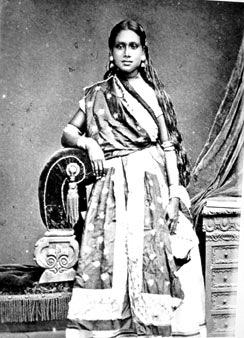|


Indentureship
– Visions of the Past
The
East Indians
The
largest
group of indentured immigrants
who came to Guyana were the East Indians,
starting under Vreed-en-hoop plantation owner
John Gladstone.

Philbert
Gajadhar, University of Guyana Arts lecturer,
says this painting of an Indian peasant girl,
adorned in traditional dress, addresses the
custom of Indian Hindus and Muslims wherein
girls were not allowed to venture out alone,
but accompanied only by a male of the
household. She looks to the future, her peers
are in the background. It forms part of the
Indentureship exhibition at the National
Museum.
They came from different districts in the
north and south of India. In the north, they
came from Uttar Pradesh, Bengal, Bihar and to
a limited extent Punjab. From the south, most
originated from the Tamil and Telinga
districts of the Madrass presidency.
They were shipped from the port of Calcutta,
and the first batch arrived here on May 5,
1838 aboard the ship, Whitby.
Between 1838- 1858,a large number were “Hill
Collies” (Dhangars, Mundas, Kols, Orgons)
from Nagpur, a sub-division of the Bengal
presidency.
Up until 1917, about 240, 000 Indians were
brought to British Guiana and allocated to
plantations around the country.

An
Indian girl who came to Guyana under
indentureship.
Much
of the traditions they brought are fading, but
the exhibition gives glimpses of what used to
be practiced.

Cooking
is one of the most important daily ritual of
an Indian wife. Familiar implements, including
the brick used for grinding massala, are
displayed.
For
example, displays of the “lorha” and “sil”,
stones used to grind massala, showcases what
were primary objects in the Indian woman’s
kitchen. Though she too toiled on the
plantations, cooking was one of the most
important daily routines of an Indian wife.
Many will tell you that coconut choka made
from grinding roasted coconut with seasoning
and pepper far out-tastes those made from
today’s modern methods.
Guyanese_jahajis
Results-National-Grade-Six
Ramphal-home-Barbados
Once-More-R
emoved
You
will see too a checkered Rumal (headscarf),
worn by Madrassi Indian women. The Rumal, (the
plain white more recognizable) though still
worn by some women, is quickly becoming a
thing of the past.
Sunday,
May 06, 2007
|
|
|
|